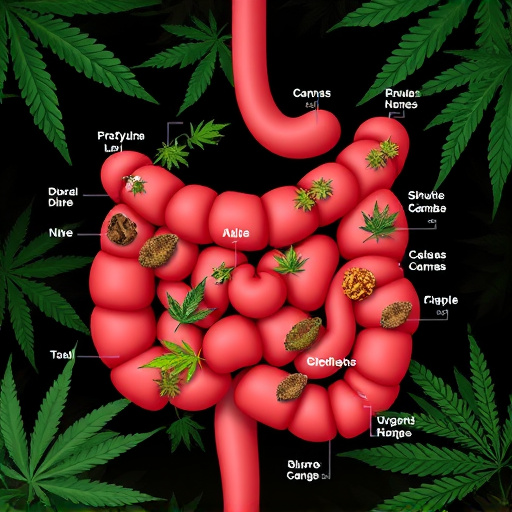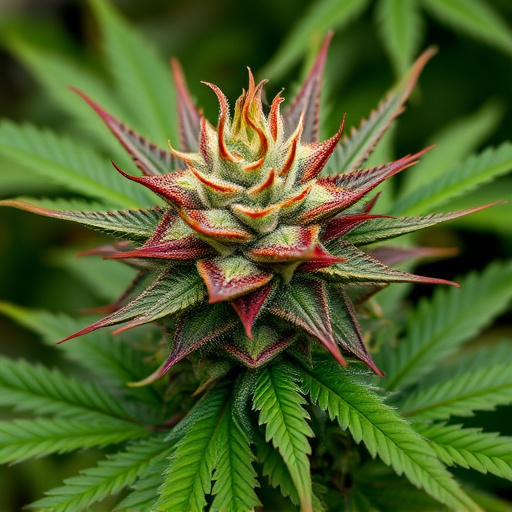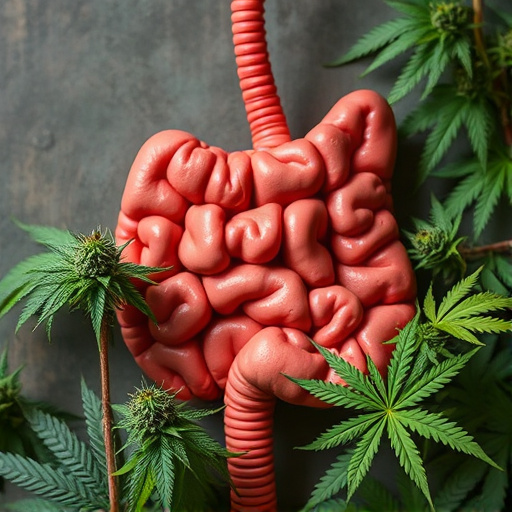Cannabis flowers' distinctive aromas stem from over 100 chemical compounds, including terpenes and cannabinoids, which combine to create varied scents and therapeutic effects. Key cannabinoids like THC and CBD are responsible for different experiences – THC offers intoxicating properties while non-intoxicating CBD is known for its anti-inflammatory and anxiolytic benefits, making it valuable in managing conditions such as Crohn's disease. Terpenes, with their diverse profiles across cannabis strains, add to the aromatic complexity and may offer additional therapeutic advantages, including relief from Crohn's symptoms through potent anti-inflammatory properties.
Cannabis flowers are renowned for their distinct, often potent aromas, which can vary widely between strains. This unique scent is driven by a complex chemical composition, with terpenes playing a pivotal role in shaping the plant’s distinctive fragrance. Beyond its allure, the relationship between specific cannabis strains and their odors holds potential therapeutic benefits, particularly for individuals managing Crohn’s disease. This article explores these aspects, delving into the science behind cannabis’ strong smells and its promising applications for patients with inflammatory bowel conditions.
- The Chemical Composition of Cannabis Flowers
- Terpenes: The Key to Cannabis Aromas
- How Cannabis Strains Affect Smell and Potential Benefits for Crohn's Disease Patients
The Chemical Composition of Cannabis Flowers

The distinctive smell of cannabis flowers is a result of their intricate chemical composition, which contains over 100 unique compounds known as terpenes and cannabinoids. These compounds work in harmony to create the plant’s unique aroma and are responsible for its therapeutic effects, including potential relief from conditions like Crohn’s disease. Each cannabis strain boasts a distinct terpene profile, contributing to the variety of scents and experiences users can expect.
Cannabinoids, such as tetrahydrocannabinol (THC) and cannabidiol (CBD), play a significant role in the plant’s scent and its effects on the human body. THC is primarily responsible for cannabis’ intoxicating properties, while CBD has gained attention for its potential therapeutic benefits, including anti-inflammatory and anxiolytic effects, which may be particularly appealing to individuals managing chronic conditions like Crohn’s disease. The combination of terpenes and cannabinoids makes cannabis flowers a complex and fascinating subject of study in the field of aromatherapeutics.
Terpenes: The Key to Cannabis Aromas

Cannabis flowers emit their distinct aromas due to a group of organic compounds known as terpenes, which are responsible for the plant’s unique scents and flavors. These terpenes play a crucial role in how different cannabis strains smell and feel. Beyond just providing a pleasant olfactory experience, terpenes may also offer therapeutic benefits, including potential relief from symptoms associated with conditions like Crohn’s disease.
Each terpene contributes to the overall profile of a strain, creating complex aromas that can range from fruity and floral to spicy and woody. They interact with cannabinoids, such as THC and CBD, to enhance or alter their effects, which is why certain cannabis strains are known for specific aromatic characteristics. Understanding terpenes helps users appreciate the nuances of different cannabis varieties and their potential effects on the mind and body.
How Cannabis Strains Affect Smell and Potential Benefits for Crohn's Disease Patients

Cannabis flowers emit their distinctive aromas due to a complex interplay of chemical compounds known as terpenes, which are responsible for the unique scents and flavors of different strains. These terpenes not only contribute to the pleasant (or sometimes unpleasant) smell but also play a crucial role in the plant’s interaction with the human body. When it comes to medical applications, certain cannabis strains have been found to offer potential benefits for Crohn’s disease patients.
Specific cannabis strains are known for their high levels of myrcene, a terpene with anti-inflammatory properties. Given that Crohn’s disease is characterized by chronic inflammation in the gastrointestinal tract, these strains could provide relief from symptoms. Additionally, terpenes like linalool and limonene, prevalent in some varieties, have been linked to improved sleep quality and reduced anxiety, which are often comorbid conditions associated with Crohn’s disease. Thus, the aroma of cannabis flowers is not merely a sensory experience but may also hold therapeutic potential for patients managing this complex condition.
Cannabis flower’s potent aroma is a result of its complex chemical composition, particularly terpenes, which not only contribute to its distinct smell but also offer potential therapeutic benefits. For patients with Crohn’s disease, specific cannabis strains can provide relief, thanks in part to their unique terpene profiles. Understanding these compounds allows for a more tailored approach to managing symptoms and highlights the importance of strain selection when harnessing the power of cannabis for medical purposes.














